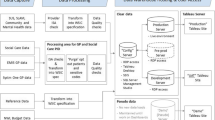Abstract
Throughout much of modern history, the physician has had two roles, “healer of the sick” and “member of a profession”. Although the distinction between these two roles has not been commonly appreciated, these roles have different historical origins and involve different activities. Viewed from this context, quality improvement is a fundamental responsibility of a profession, and databases and registries, created and maintained by professional groups that are focused on patient outcomes, are a critically important tool by which quality improvement can occur. Database/registry participation, careful review of the resulting outcomes data, and active attempts to improve the quality of our patients’ outcomes are thus fundamental to both being better “healers of the sick” and responsible “members of a profession.”.
Access provided by Autonomous University of Puebla. Download chapter PDF
Similar content being viewed by others
Keywords
Throughout much of modern history, the physician has had two roles, “healer of the sick” and “member of a profession” [1]. Although the distinction between these two roles has not been commonly appreciated, these roles have different historical origins and involve different activities [1]. Professions were created by and exist for the benefit of the general society as a means of organizing the delivery of complex services which society requires, including that of the healer. Characteristics of a profession include (1) an occupation whose core element is work based upon mastery of a complex body of knowledge and skills (2) knowledge or practice of a knowledge-based art that is used in the service of others, (3) governance by codes of ethics, (4) commitments to competence, integrity and morality, and (5) altruism and promotion of the public good [2]. The relationship between society and a profession has been described as a “social contract” with implied prerogatives and responsibilities for each profession [1]. Among the most important of these professional responsibilities is the expectation that the profession will act in the societal interest and not its own [3]. Other responsibilities articulated by a number of different individuals and organizations include (1) maintaining, advancing, and disseminating a body of knowledge, (2) setting and enforcing its own standards and values, i.e. self-regulation, (3) cherishing performance above personal reward, (4) placing patients’ interests above their own, and (5) fairly distributing finite medical resources [2].
Viewed from this context, quality improvement is a fundamental responsibility of a profession, and databases and registries, created and maintained by professional groups that are focused on patient outcomes, are a critically important tool by which quality improvement can occur. These databases foster the dissemination of knowledge and mastery of a complex body of knowledge and can be an important vehicle for setting and enforcing standards and evaluating performance. Ultimately these databases and registries can serve as a mechanism for the wise allocation of societal resources for healthcare, provided that both government and private payors will provide the resource utilization data. Database/registry participation, careful review of the resulting outcomes data, and active attempts to improve the quality of our patients’ outcomes are thus fundamental to both being better “healers of the sick” and responsible “members of a profession.” The accompanying body of work represents a clear manifestation of these professional efforts. This herculean effort led by 4 internationally respected leaders and drawing the best wisdom around the world represents a major milestone in the development and progress of safe and high valued pediatric cardiac care.
References
Creuss RL, Creuss SR. The Osler Fellows program: physicianship, professionalism, and medicine’s social contract with society [Powerpoint file]. Available at: http://www.medicine.mcgill.ca/physicianship/Presentations/Intro%20to%20Preofessional%20for%20Osler%20Fellows.ppt. Accessed 13 Apr 2014.
Mayer Jr JE. Is there a role for the medical profession in solving the problems of the American health care system? Ann Thorac Surg. 2009;87:1655–61.
Krause EA. Death of the guilds: professions, states, and the advance of capitalism, 1930 to the present. New Haven: Yale University Press; 1996. p. 29–49.
Author information
Authors and Affiliations
Corresponding author
Editor information
Editors and Affiliations
Rights and permissions
Copyright information
© 2015 Springer-Verlag London
About this chapter
Cite this chapter
Mayer, J.E. (2015). Introduction: Quality Improvement and Databases in the Context of Professionalism. In: Barach, P., Jacobs, J., Lipshultz, S., Laussen, P. (eds) Pediatric and Congenital Cardiac Care. Springer, London. https://doi.org/10.1007/978-1-4471-6587-3_4
Download citation
DOI: https://doi.org/10.1007/978-1-4471-6587-3_4
Published:
Publisher Name: Springer, London
Print ISBN: 978-1-4471-6586-6
Online ISBN: 978-1-4471-6587-3
eBook Packages: MedicineMedicine (R0)




